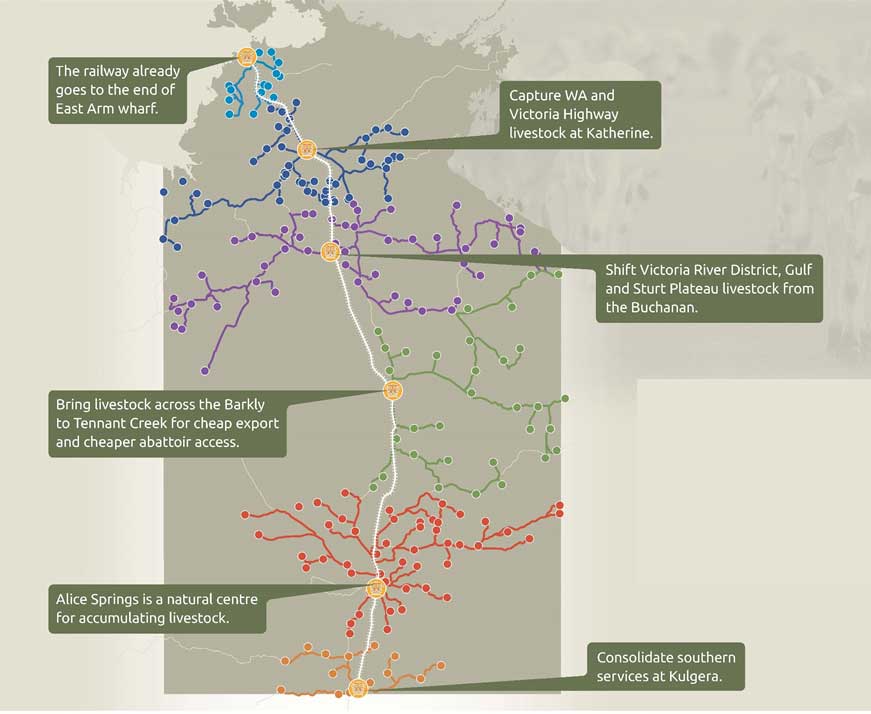Back on track - the role of rail in transporting livestock
If you consider the way air travel works with many domestic flights converging at major hubs from which international flights can arrive and depart, you can gain an appreciation for the role rail freight can and does play in Australia. Not every country airport has or needs an international service or a Qantas Club, but the main service hubs do.

Rail freight is not a threat to road freight, it is a complementary service. Therefore, it presents opportunities. Rail services will depend on road freight because cattle don’t just show up at railheads by themselves, or walk themselves off to market when the train pulls in. Trucks will always be required to move livestock to the train, from the train, and wherever the train does not run. But for locations on the rail line, the train should be used so the economic, environmental and efficiency benefits can be exploited.
Railheads provide opportunities for regional development, and the various depots could become service hubs for a multitude of purposes.
The cost of using rail services for livestock transport is calculated based on container freight, where prices for shifting a 40-foot container are published each year by the railway companies. Road stock crate trailers are also 40 feet long, so it is relatively easy to compare road costs with rail costs. For the ease of calculations, livestock are taken to weigh 400 kilograms each and to be loaded at 20 animals to the deck, and 20 animals to the container.
A model of the Northern Territory’s cattle stations and key beef cattle destinations was made to derive the most cost-efficient method of moving livestock between each origin and destination.
According to the model, 93% of the Territory’s herd could travel by road to a railhead, then board the train to East Arm Wharf, and arrive for $2.86 per head less than if they travelled on trucks alone. However, more impressively, 98% of the Territory’s herd could travel to a South Australian abattoir for $145 per head less, if the cattle got off the train in Adelaide before final road delivery to the abattoir. For a 400 kilogram animal, the saving is equivalent to 36 cents per kilogram.
| Northbound to East Arm Wharf | Southbound to abattoirs | |||
|---|---|---|---|---|
| Territory herd | Rail discount to road $/head | Rail origin | Rail discount to road $/head | Territory herd |
| East Arm depot | -186.20 | 4% | ||
| 10% | -2.10 | Katherine depot | -177.05 | 13% |
| 20% | -1.03 | Buchanan depot | -166.01 | 37% |
| 22% | -4.28 | Tennant Creek depot | -124.98 | 31% |
| 9% | -5.24 | Roe Creel depot | -95.01 | 10% |
| 2% | -9.24 | Kulgera depot | -78.63 | 3% |
| 93% | -2.86 | Total | -145.72 | 98% |
The model also analysed livestock transport movements over the last decade. Of the 1,068,000 head that move through the Territory on average each year, around 280,000 head travel between locations that could benefit from a rail service, at a weighted average saving of $30.96 per head, representing savings of over $8.6 million per year.
| Rail direction | Rail origin | Head of cattle | Discount with rail $/head |
|---|---|---|---|
| Buchanan depot | 36,500 | -0.44 | |
| Tennant Creek depot | 62,600 | -2.16 | |
| Roe Creek depot | 5,200 | -6.48 | |
| Kulgera depot | 2,200 | -6.46 | |
| Northbound total | 116,700 | -1.97 | |
| Southbound | East Arm depot | 12,100 | -26.54 |
| Katherine depot | 37,700 | -31.91 | |
| Buchanan depot | 33,900 | -42.40 | |
| Tennant Creek depot | 25,200 | -44.03 | |
| Roe Creek depot | 40,200 | -82.69 | |
| Kulgera depot | 14,200 | -73.51 | |
| Southbound total | 163,300 | -51.68 | |
| TOTAL | 280,000 | -30.96 |
Potential cost savings based on container freight are real, and further exploration of the related opportunities could deliver regional development, animal welfare improvements, and service delivery benefits to all stakeholders.
